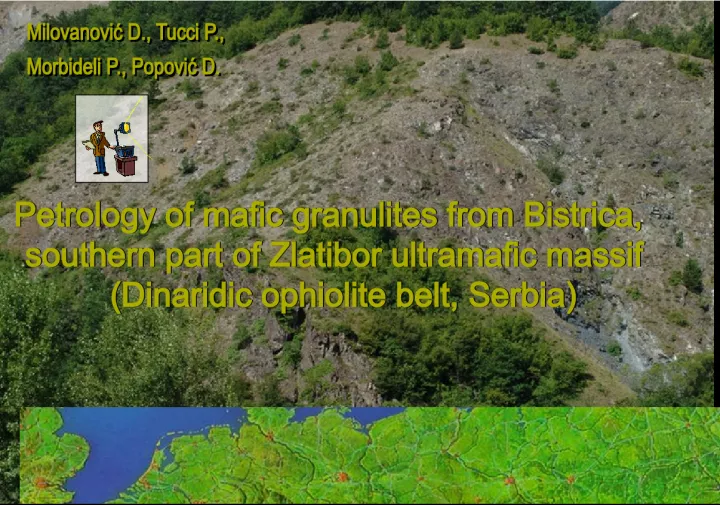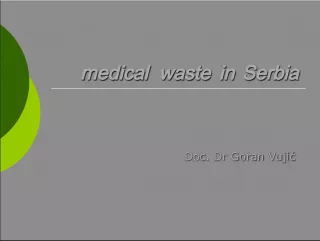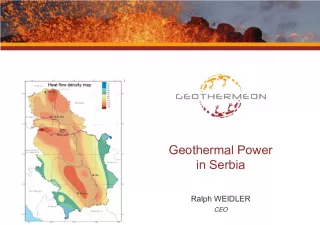Petrology of mafic granulites from Bistrica, Zlatibor ultramafic massif, Serbia


This study analyzes the composition and mineralogy of mafic granulites from Bistrica in the southern part of the Zlatibor ultramafic massif within the Dinaridic ophiolite belt in Serbia.
- Uploaded on | 0 Views
-
 marshallalvarez
marshallalvarez
About Petrology of mafic granulites from Bistrica, Zlatibor ultramafic massif, Serbia
PowerPoint presentation about 'Petrology of mafic granulites from Bistrica, Zlatibor ultramafic massif, Serbia'. This presentation describes the topic on This study analyzes the composition and mineralogy of mafic granulites from Bistrica in the southern part of the Zlatibor ultramafic massif within the Dinaridic ophiolite belt in Serbia.. The key topics included in this slideshow are Petrology, mafic granulites, Bistrica, Zlatibor ultramafic massif, Dinaridic ophiolite belt,. Download this presentation absolutely free.
Presentation Transcript
1. Milovanovi D., Tucci P., Morbideli P., Popovi D. Milovanovi D., Tucci P., Morbideli P., Popovi D. Petrology of mafic granulites from Bistrica, southern part of Zlatibor ultramafic massif (Dinaridic ophiolite belt, Serbia) Petrology of mafic granulites from Bistrica, southern part of Zlatibor ultramafic massif (Dinaridic ophiolite belt, Serbia)
2. A L P S A P E N I N E S T H K A R P A O A B A L K N I D E S D I N A R I D E S General position General position
3. TISSIA VMT VMT SPPT SPPT HT HT KT KT RVOT RVOT RVOT RVOT SMCT SMCT VZCT VZCT KBT KBT KBT KBT JB JB DIT DIT DIT DIT VZWT VZWT VZWT VZWT DOT DOT EBDT EBDT DHC T DHC T Concept of terranes by Concept of terranes by Prof Stevan Karamata Prof Stevan Karamata GEOLOGICAL MAP OF SERBIA&MONTENEGRO 1:500 000 GEOLOGICAL MAP OF SERBIA&MONTENEGRO 1:500 000 Pillow lavas Ultramafites Limestones Melanges
4. Definition of term - mafic granulite Definition of term - mafic granulite (A proposal on behalf of the IUGS Subcommision on the Systematics of Metamorphic Rocks,(Web version of 31.10.2002) (A proposal on behalf of the IUGS Subcommision on the Systematics of Metamorphic Rocks,(Web version of 31.10.2002) Granulite is a high-grade metamorphic rock in which Fe- Mg-silikates are dominantly hydroxil- free .... Granulite is a high-grade metamorphic rock in which Fe- Mg-silikates are dominantly hydroxil- free .... The basis of the rocks names is their mineralogy and structure. The basis of the rocks names is their mineralogy and structure. The rocks with >30% mafic mineral may be called mafic granulites. The rocks with >30% mafic mineral may be called mafic granulites. The term should not be applied to calcsilicate rocks, marbl, ironstones and quartzites. The term should not be applied to calcsilicate rocks, marbl, ironstones and quartzites.
5. Ultramafic rocks Ultramafic rocks Mafic granulites Mafic granulites Grt Py Plg Amph
6. Grt Chemistry of minerals Py Amph Plagioclase is Anorthite
7. Degrees of metamorphism
8. Grt Grt Amph Amph Py Py Pl Pl Grt-Py = 900-1000 0 C, 10 kbars Grt-Py = 900-1000 0 C, 10 kbars Grt-Ho = 830-880 0 C, 8-10 kbars Grt-Ho = 830-880 0 C, 8-10 kbars Reactions: Baz.Pl+PyI+H 2 O=Grt+PyII HoII+An or Baz.Pl+PyI+H 2 O=Grt+PyII HoII+An or Baz.Pl+ HoI PyI =Grt+PyII HoII +An+H 2 O Baz.Pl+ HoI PyI =Grt+PyII HoII +An+H 2 O T P Opx-free Grt+Cpx+Pl Qtz assemblages Amphibolite Amphibolite Eclogite Granulite Granulite Opx+Cpx+Pl+Hbl+ Qtz) Grt+Cpx+Opx+Pl ( Hbl or Qtz) Cpx+Grt Amph Qtz ) Grt+Cpx+Pl ( Hbl or Qtz) Grt+Cpx+Pl +Hbl+Qtz Hbl+Pl+Qtz (Grt or Cpx) Grt+Cpx+Pl +Hbl+Qtz 1000 T ( 0 C) 800 600 400 0 4 8 12 16 P (kbar) Qtz- absent Qtz- present W&N 91 S&D 94 Hbl Pl Qtz Grt Cpx L Grt Cpx Qtz Pl Pl Opx Hbl Qtz L V Pl Opx Qtz Cpx Hbl L Hbl+Qtz= Opx+Cpx+Pl+V P&B 95 R 93 C 88 E&T 86 W&W 94 N&C 00 b N&C 00 a P 68, J 78 and WW 93 P&B 95 B&L 91 CWT 67 B 69 S 81 R 91 Experimental constraints Degrees of metamorphism There are significant discrepancies between experimental and natural constraints on the PT conditions of opy-free grt + cpy+ p l Q bearing mineral assemblages and therefore on the PT position of this reaction.
9. Protolith
10. No fractionation of Pl ? Contamination, Partial melting ? Protolith Subduction ?
11. CONCLUSIONS Major and trace element whole-rock geochemical data indicate that metamorphism was broadly izochemical G arnet- clino pyroxene- hornblende- plagioclase thermo - barometry indicates peak metamorphic conditions of about 900-1000 C and 830-880 C at pressures 8-10 kbars Difference in temperature most probably represents a succesion of mineral forming in a cooling period under which hornblende was formed. A bsence of thermal relaxation features in mafic granulites require metamorphism with rapid exhumation F abrics of ultramafic rocks and mafic granulites suggest that development of the Grt- Cpx- Ho-Pl assemblages is connect with ophiolite e mplacement , subduction , rather than having been caused by heat from the ophiolite. METAMORPHISM 1000 T ( 0 C) 800 600 400 0 4 8 12 16 P (kbar) Qtz- absent Qtz- present W&N 91 S&D 94 Hbl Pl Qtz Grt Cpx L Grt Cpx Qtz Pl Pl Opx Hbl Qtz L V Pl Opx Qtz Cpx Hbl L Hbl+Qtz= Opx+Cpx+Pl+V P&B 95 R 93 C 88 E&T 86 W&W 94 N&C 00 b N&C 00 a P 68, J 78 and WW 93 P&B 95 B&L 91 CWT 67 B 69 S 81 R 91 Experimental constraints Gr+Py Gr+Ho
12. Whole rock compositions , with well defined positive Eu anomalies indicate that protoliths of mafic granulites from Bistrica have a cumulus origin. Whole rock compositions , with well defined positive Eu anomalies indicate that protoliths of mafic granulites from Bistrica have a cumulus origin. PROTOLITH PROTOLITH Distinguishing oceanic plateau basalts from MORB is more difficult, because all geochemically gradations exist between these basalts. Distinguishing oceanic plateau basalts from MORB is more difficult, because all geochemically gradations exist between these basalts. The trace element, rare earth element data suggest that Mafic granulites of Bistrica have protolith features resembling mid-ocean ridge basalt (MORB). The trace element, rare earth element data suggest that Mafic granulites of Bistrica have protolith features resembling mid-ocean ridge basalt (MORB). The low silica content could be due to loss of a silicic melt (or fluid) during subduction , or loss of SiO2 during seafloor alteration The low silica content could be due to loss of a silicic melt (or fluid) during subduction , or loss of SiO2 during seafloor alteration Partial melting or dehydration of the subducted oceanic crust causes loss of LREE Partial melting or dehydration of the subducted oceanic crust causes loss of LREE Mafic granulites could represent deep cumulus portions of subducted oceanic crust ( olivine gabbros ?) Mafic granulites could represent deep cumulus portions of subducted oceanic crust ( olivine gabbros ?) Lack of sheeted dyke complexes in investigated area may suggest also an oceanic plateau ( ophiolites formed in back arc basins ?) Lack of sheeted dyke complexes in investigated area may suggest also an oceanic plateau ( ophiolites formed in back arc basins ?) CONCLUSIONS
13. Metamorphic changes are most probably related with subduction off oceanic c rust (basaltic rocks) during formation of Dinaridic ophiolite belt in Jurassic (?) Metamorphic changes are most probably related with subduction off oceanic c rust (basaltic rocks) during formation of Dinaridic ophiolite belt in Jurassic (?) CONCLUSIONS
14. THANK YOU



